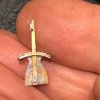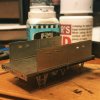jonte
Western Thunderer
Hill Walking
Stuttering steps, in the wrong socks. Having gone around and around in TinkerCAD, the box of brass became more and more attractive. Thus, in the space over Christmas 202o, a start was made.
Via the GERS drawing, it very quickly became apparent that something was awry:
View attachment 145115
The Running Plate - a wonderful reimagining of some scrap fret by the previous builder - was some 1'6" too long in real money. This was addressed using the Exacto cuting guide, with the Running Plate resting on some HSS steel bars:
View attachment 145119
New buffer beams were cut from NS sheet.
The boiler was also incorrectly sized; the cunning use of a piece of central heating pipe sadly resulted in a barrel 6" too small in diameter.
Thanks to the generosity of @lankytank the correct size was soon in place:
View attachment 145120
Attention then turned to the Firebox; after a back-of-a-fag-packet calcualtion, a simple wraparound a suitably-sized drill shank resulted in the required shape:
View attachment 145121
The ends (throat and backhead) were added using lead sheet of a suitable thickness, soldered in place with 70 degree lowmelt:
View attachment 145122
..the curves of which were shaped with a scraper made from scrap brass:
View attachment 145123
..with the motor aperture being fretted out:
View attachment 145124
The resulting box was offered up to the boiler/smokebox assembly and tacked to the footplate:
View attachment 145125
Attention then turned to the cab front:
View attachment 145126
Lots of painful curves, here. The distinctive 'sad eye' look of these engines took some calculating and transference. A nice sharp set of dividers was key, here. The it was out with the fret saw and files:
View attachment 145129
Some more filing, a lot of cussing, and a few hours away from the bench resulted in something that looked the part:
View attachment 145130
The sidetanks were relatively straightforward, the only oddity being that it was decided to model the hole of the bunker on the Fireman's side of the cab:
View attachment 145131
...and that seems like a logical place to stop. The next post will add detail on the cab rear.
Most enjoyable, and - as a first attempt at a scratchbuild - going well. But We haven't attempted the Walschearts valve gear, yet!
Cheers
Jan
Finding it hard to believe that this fine example of craftsmanship is your first attempt, Jan. Astounding stuff.
Jonte























